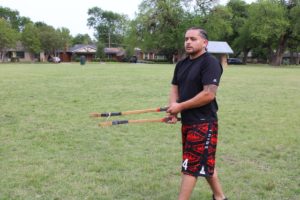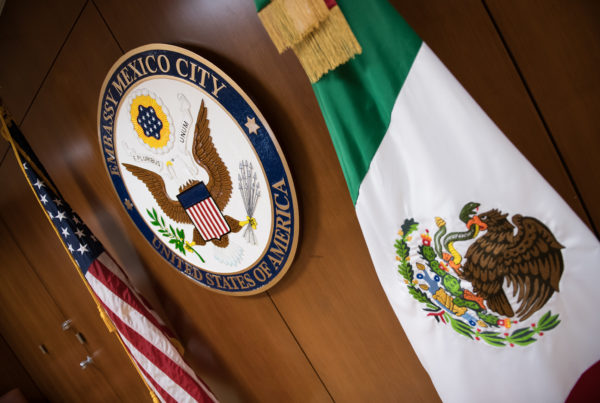From KERA News:
On a Sunday afternoon in Kiest Park in Dallas’ Oak Cliff neighborhood, the clanging of sticks echoes across a grassy field as members of DFW Kabutcha Toli — a local stickball team — play at their weekly practice.
Stickball is a sport where opposing teams use handcrafted sticks to vie for a ball and hit a pole or make a goal, depending on the region where the game is being played.
Eli J. Hickman founded DFW Kabutcha Toli back in 2018 to find other people to play with when he first picked up the sport. Four years later, the club has about 30 members, a mix of older North Texans, men, women and children.
“Our tagline for this group is called ‘Building Community Through Harder Hits’ and we say harder hits, so that could be like we’re crashing with each other,” Hickman said. “But in the beginning for me, it was actually coming out and practicing in public because back then it was just me by myself and just to break out of my barriers that I had for myself.”
The club has made stickball more accessible for local Native Americanswhose ancestors first invented the sport, which was likely played as early as 1000 A.D. For Hickman, who grew up in Oak Cliff, it’s a way to hold onto a tradition that has deep roots in the indigenous community. Many of the members are also part of Little Brother of War, a group that hosts stickball demonstrations to educate the public.

North Texan Hoss Villa practices throwing the ball at a stickball practice on Sunday, May 1, 2022 at Oak Cliff’s Kiest Park.
Hoss Villa, who joined the club four years ago, said Sunday practices help him get away and remember his indigenous roots as a Chichimeca Coahuiltecan Indian, or what he refers to as “Southern Native.” Those are indigenous communities native to what’s now considered northeastern Mexico and southern Texas.
“Just when you’re out in that field and you’re playing in a game, it’s like you kind of escape from this little colonial world,” he said. “You’re in a place where none of this out here matters, kind of like a time machine. You just go back in time and play, and that’s it for that little time frame you get to kind of get away from life today.”
Stickball: A Native American ‘Way Of Life’
In many ways, stickball is “a way of life” for indigenous communities, according to Terry Scott Ketchum, who is Mississippi Choctaw of Oklahoma and an assistant professor of cultural anthropology and Chickasaw endowed chair of Native American Studies at East Central University in Oklahoma.
“The way they explain it is this game was played even before humans were on the Earth, before there was really just all water here,” he said. “It was a game that was played on the other side by the creator — and so it has a deep connection.”
Referenced as “The Creator’s Game,” Ketchum said there’s a Native saying that the game was given to Indigenous people so that clan mothers wouldn’t have to send their grandsons off to the battlefield.
The game has also been coined the “Little Brother of War” because it was used as a means of conflict resolution that “would allow the same kind of diplomatic outcomes from a violent conflict.”
Historically, stickball has also been central to Indigenous communities as a way to teach about spirituality, maintain cultural connection and as a form of social empowerment, Ketchum said. But there was a shift away from these values around the 1830s when the sport of lacrosse emerged from stickball.
“[Lacrosse] was kind of moved away from that cultural context,” Ketchum said, “and really became this kind of very competitive … pastime.”
Lacrosse really began to take hold as a sport in the Americas following an exhibition of indigenous games across the U.S. and Canada around 1830, according to Ketchum. At about this time, there was active pressure on Indigenous people to submit to Western norms through forced relocation.
Canadians started the first non-native lacrosse teams in the 1850s, Ketchum said, and the sport became a mainstay in colleges across the Northeastern U.S. by the early 1900s.
In the modern day, lacrosse is still closely associated with wealthy elite spaces like Ivy league universities in the Northeast; and is often less accessible for Native Americans communities.
“It has become kind of reflective of these very material-privileged spaces that are not necessarily when you think about the kind of humble beginnings that the cultural game teaches versus the competitive game that we see today in the recreational and the pro sport,” Ketchum said.
That’s why he says there is often a “disconnection” from the indigenous origins of the game. But at the same time, he emphasizes that scholars and native communities are working to educate the public about that valuable history like how lacrosse came to receive its name.
“Lacrosse” was first coined by a French Jesuit priest in Canada who saw a game and compared the sticks to those of Jesuit priests. The word diverged from the original terminology of stickball in Indigenous languages that referenced bumping hips or a stick kabutcha.
While lacrosse is stickball’s successor, both games continue to be played now — which Ketchum says is unique.
“Oftentimes, players who play in one will play in both,” the cultural anthropologist said. “You have a lot of Iroquois Haudenosaunee members who play box lacrosse, but who at the same time also play community games as well.”
Fighting to survive

The sticks used to play stickball are traditionally made out of hickory bark. The netting at the end of the stick allows players to pick up balls.
What many people don’t know is that the survival of stickball is made more remarkable by the fact that the U.S. government tried to eliminate the sport for over a century, and it was expected to die out.
“The missionaries were trying to really integrate Native people into what they considered everyday American life and so the game was really seen to have a lot of savage elements to it,” Ketchum said. “There was definitely a misunderstanding of the cultural aspects of the game.”
Ketchum is working on a book about “the United States’ effort to eradicate the game of stickball” that will look at how federal law shaped the game, including efforts to “civilize” Native Americans through missionary-run schools, and the 1887 Dawes Act, which halted a variety of indigenous practices.
“There was a fear that these cultural practices would still allow Native people to coalesce and come together and they wouldn’t integrate,” he said.
However, rather than let the sport die away, Indigenous communities took stickball underground – with some communities playing in the dead of night.
“When they would score, you’d hear that ding and then everyone knows someone scored and [you would hear them] clapping their sticks,” Ketchum said.
Stickball hasn’t just survived, it’s remained a beloved Indigenous sport that culminates in the World Series of Stickball at the annual Choctaw Indian Fair in Mississippi. Thousands usually attend or virtually watch the summer event on YouTube.
Fort Worth: A professional lacrosse venue
Its successor lacrosse has also thrived as a popular pastime in the U.S. with a number of high school, college and professional teams. In fact, Fort Worth’s Dickies Arena is home to the Panther City Lacrosse Clubwhich is part of the National Lacrosse League.
Panther City’s Jeremy Thompson is a member of the Onondaga Nation and a Canadian who commutes between Fort Worth and his home outside of Toronto. He’s one of the few Panther City players who plays lacrosse full-time and is sponsored by Nike.
His influence in the sport — along with his three brothers who are also professional lacrosse players — led to a collaboration with Nike to create its first lacrosse cleat, the Huarache V.
Thompson said he grew up playing stickball and started playing lacrosse around the age of 9.
“If you come from Six Nations or Haudenosaunee, it’s like you were born with a wooden stick,” he said.
Thompson said the game was passed down as a kind of medicine “to heal people mentally, emotionally that might be down in the community.” Given the history of violence and oppression against native people, Thompson said it’s an important tradition to heal from the past.
“There was obviously genocide — and so that’s always a huge part of it, that our people are kind of coming full circle and kind of knowing who they are, their voice in themselves,” he said.
It’s the deeply rooted native history and tradition that the average viewer at a lacrosse game might not know about, which is why Panther City invited the indigenous community in North Texas to lead an Origins Night in February. Local advocates planned the event to educate the audience on the native origins of lacrosse through special performances and demonstrations, including one by Little Brother of War.
“The Panthers had their first home win, Jeremy Thompson was named player of the game, Native American culture was celebrated and honored plus for some members of the community who had not seen each in months due to the pandemic,” said Rachel F. Salinas, president of the AT&T Intertribal Council. “It was a welcomed reunion. It was a good night. It was good medicine.”
Thompson’s involvement in the team has sparked interest among Native Americans in North Texas and it’s brought a number of them out to Panther City games.
While the game is no longer used to end diplomatic disputes, cultural anthropologist Scott Ketchum says it still plays a vital role in indigenous communities as a form of social empowerment — especially for native youth. It’s a way to remind indigenous people of their roots and has important team-building qualities.
Panther City lacrosse player Jeremy Thompson, who has hosted lacrosse camps for Native American youth, agrees.
“I think it’s really all about coming together as people, as individuals,” he said. “They say in our culture putting our minds together as one is kind of feeding into one concept overall and prospering for many different people throughout our communities and the world. It’s kind of just taking from the same dish, one spoon kind of concept.”















